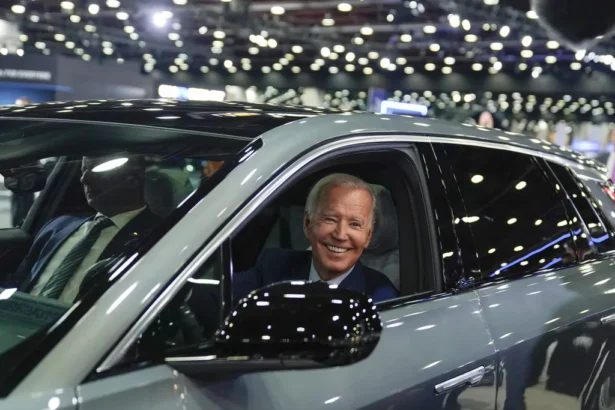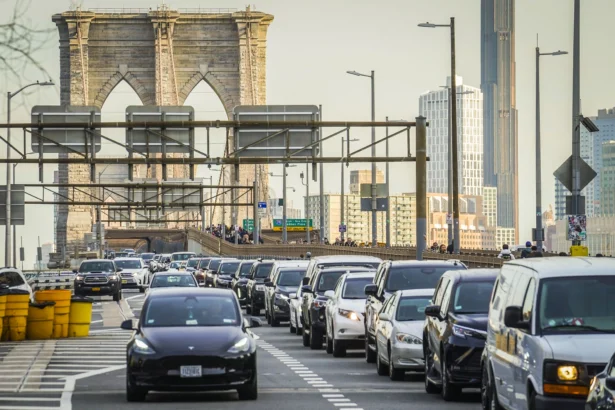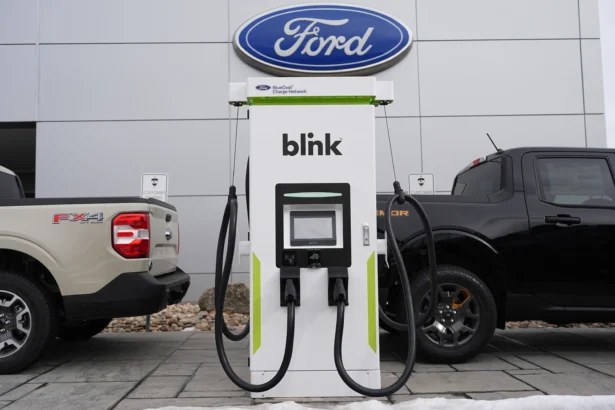The Biden administration announced on Wednesday that it would relax automobile emissions standards previously aimed at boosting electric vehicles (EVs) and cutting carbon emissions.
The tailpipe limits proposed last year by the Environmental Protection Agency EPA will be relaxed for 2027 through 2029 without changing the initial end objective, leaving it to the industry to catch up with the arrears from 2030 to 2032.
The rules come as sales of EVs, which are instrumental to meet the standards, have begun to slow.
The car industry could meet the standards if EV sales increase steadily to account for 56 percent of all car sales by 2032, along with at least 13 percent hybrids, the EPA said.
“Let me be clear: Our final rule delivers the same, if not more, pollution reduction than we set out in our proposal,” EPA Administrator Michael Regan told reporters. In addition to carbon pollution, the final standards also reduce other serious air pollution that contributes to health issues like heart attacks, respiratory illnesses, aggravated asthma, etc, Mr. Regan added.
According to the EPA, the new standards will avoid more than 7 billion tons of carbon emissions over the next three decades and provide $100 billion in annual net benefits, including lower health care costs, fewer deaths, and an alleged $60 billion in reduced annual costs for fuel, maintenance, and repairs.
“These new standards are so important for public health, for American jobs, for our economy and for our planet,” Mr. Regan said.
Changed Plans
Car makers’ opposition to environmental restrictions has steadily increased as the industry faces numerous challenges to realize the transition to EVs—such as foreseeable problematic bottlenecks in the supply of lithium, insufficient charging infrastructure, etc.—while a “silent majority” questions the ecological rationale behind the push for EV’s when the bulk of electricity is generated by carbon-emitting fossil fuels.
In January, more than 4,700 auto dealerships across the United States urged President Biden to halt the EPA’s stricter vehicle pollution standards proposed in April after an earlier letter signed in November by nearly 4,000 dealerships had allegedly remained unanswered.
With consumers currently being held back by cost, range, and a lack of publicly available charging stations, the auto industry said the EPA’s projected sales of EVs necessary to attain the goal were unrealistic.
Though Mr. Regan earlier said the new rule was a performance standard that leaves it to the industry to come up with solutions, the amendments to the standards are designed to be technology-neutral and performance-based, allowing car and truck manufacturers the flexibility to choose pollution-control technologies that are best suited for their customers within environmental and public health requirements.
Political Motivations?
President Joe Biden has made fighting climate change a priority of his agenda and is seeking to slash emissions from gasoline-powered vehicles, which make up the largest source of U.S. greenhouse gas emissions.
The United Auto Workers union, which has endorsed Mr. Biden, has said it favors the transition to electric vehicles but wants to ensure that jobs are preserved and that the industry pays top wages to workers who build the EVs and batteries.
In light of the upcoming elections, Mr. Biden will need the political support from auto workers, a key political voting bloc.
White House press secretary Karine Jean-Pierre said Tuesday that White House officials “don’t have any concerns” about the final EPA rule. “We know, with these types of things, it takes time,” she told reporters. “But we’re still going to stay committed to our [climate] goals.”

At a Detroit-area rally in September, President Donald Trump insisted President Biden’s embrace of electric vehicles would ultimately lead to job cuts. “He’s selling you out to China, he’s selling you out to the environmental extremists and the radical left,” President Trump told the crowd, flanked by American flags and pallets of auto parts.
Last week, when speaking about the car industry during an Ohio rally, President Trump warned that President Biden’s policies would lead to an economic “bloodbath” if President Biden is reelected—a statement eagerly pulled out of context by corporate media over the weekend.
It remains a question whether the EPA’s car emissions rule will remain in effect under a Trump presidency, be it in part or wholly.
Besides electoral reasons, the EPA’s emissions standards may also face legal challenges, with the U.S. Supreme Court having repeatedly reined in the powers of federal agencies in recent years over matters of overreach.
One landmark 2022 ruling, for instance, limited the EPA’s authority to regulate carbon dioxide emissions from power plants that contribute to global warming.
Opponents in both industry and politics have called the rule an “EV mandate,” but Mr. Regan believes that accusation to be legally groundless.
“You know, maybe some would like for it to be an EV mandate, but that clearly is not the case,” he said. “We are staying well within the confines of the law and our statutory authority by not mandating a specific technology.”

Feedback
Environmental groups have generally responded optimistically about the new EPA rule.
“Over time, these rules will prevent more carbon pollution than the entire U.S. economy coughs up in a year,” said Manish Bapna, president of the Natural Resources Defense Council, claiming the rules “will save drivers money at the pump and cut tailpipe pollution that endangers public health.”
“In the longer journey to confront the climate crisis, these standards take us in the right direction,” he said.
“This is a day to celebrate American achievement,” said Amanda Leland, executive director of the Environmental Defense Fund, another environmental group. She believed the new EPA rule would “bring more jobs for workers, more choices and more savings for consumers and a healthier future for our children.”
Dan Becker at the Center for Biological Diversity was less enthusiastic, believing the industry will use loopholes to continue selling gas-driving cars.
“The bottom line is that the administration is caving to pressure from big oil, big auto and the dealers to stall progress on EVs and now allow more pollution from cars,” he said.

The Alliance for Auto Innovation, a large industry trade group, welcomed the EPA’s decision. The group had complained that the initial proposal to ramp up the sale of all-electric vehicles to 67 percent was impossible for the industry to achieve.
“Moderating the pace of EV adoption (from 2027 through 2030) was the right call because it prioritizes more reasonable electrification targets in the next few, very critical years of the transition,” said John Bozzella, the Alliance CEO.
Mr. Bozzella said that the adjusted emissions targets will still be a stretch for the industry to achieve, but they should give the market and parts supply chains a chance to catch up to higher EV sales. The plan also gives the industry more time to set up public charging stations, and it allows government tax incentives for EV manufacturing, and for consumers to buy EVs to take hold, he said.
U.S. electric vehicle sales grew 47 percent last year to a record 1.19 million as EV market share rose from 5.8 percent in 2022 to 7.6 percent. However, EV sales growth slowed toward the end of the year.
The Associated Press contributed to this article.


